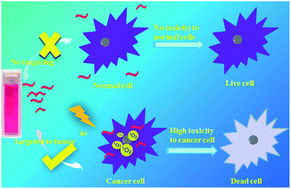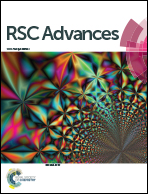BODIPY-based macromolecular photosensitizer with selective recognition and enhanced anticancer efficiency†
Abstract
Photodynamic therapy (PDT) is attracting ongoing attention for treatment of cancer as a noninvasive technique. A BODIPY-based macromolecular photosensitizer, p(GEMA-co-BODIPYMA)-2I, with high water solubility, specificity recognition to cancer cells and no dark cytotoxicity was prepared, which achieved enhanced therapeutic efficacy and reduced side-effects. P(GEMA-co-BODIPYMA)-2I generated 1O2 (ΦΔ = 0.79) rapidly in aqueous system and confocal laser scanning microscopy (CLSM) images showed that p(GEMA-co-BODIPYMA)-2I was avidly taken up specifically by cancer cells, however, couldn't be uptaken by normal cells. The novel photosensitizer displayed high photocytotoxicity for cancer cells, but not normal cells. The cell viability of normal cells was over 80% when the concentration was 20 nmol mL−1 under illumination for 10 min and that for cancer cells was 0.4% under the same conditions. Our facile strategy provides a novel avenue for the effective development of photosensitizers for cancer therapy.


 Please wait while we load your content...
Please wait while we load your content...